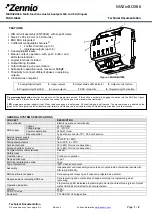
PD1 (always ON)
All modules for essential operation of
microcontroller (Cortex-R5F CPUs, Level 1
cache memory, Level 2 Flash memory, Level 2
SRAM, Interconnect, Clock control, Basic
peripheral set)
PD2
ETM-R5, TPIU,
CTI, CTM, ATB,
RTP, DMM
PD3
MIBADC2, MIBSPI4,
MIBSPI5, DCAN3,
DCAN4, NHET2,
HTU2, SCI3, SCI4,
I2C1, I2C2
PD4
FlexRay, FTU
PD5
Ethernet, EMIF
PD6
ePWM[1..7],
eCAP[1..6],
eQEP[1..2]
Switchable domains
Power Domains
282
SPNU563A – March 2018
Copyright © 2018, Texas Instruments Incorporated
Power Management Module (PMM)
5.2
Power Domains
shows the core domains implemented on the microcontroller.
This device has 6 separate core power domains:
•
PD1 is an always-ON domain and is not controlled by PMM. It contains the CPU as well as other
principal modules and the interconnect required for operation of the microcontroller. This domain also
includes the level 1 cache memory and the level 2 flash memory and SRAM. The PD1 can operate on
its own even when all the other core power domains are turned off by the PMM. Note that all I/Os are
in this always-ON domain as well.
Core power domains PD2 through PD6 are controlled by the PMM.
•
PD2 contains logic related to debug, instrumentation and trace such as the Embedded Trace Macrocell
(ETM-R5), RAM Trace Port (RTP), and Data Modification Module (DMM) components.
•
PD3 contains some additional peripheral modules as an enhanced configuration over and above the
peripheral set available in PD1. These include a second High-End Timer (N2HET2) with its dedicated
transfer unit (HTU2), a second Analog-to-Digital Converter (ADC2), two Serial Communication
Interfaces (SCI3 and SCI4), two Inter-Integrated Circuit controllers (I2C1 and I2C2), two Controller
Area Network controller (DCAN3 and DCAN4), and two Multi-buffer Serial Peripheral Interface module
(MibSPI4 and MibSPI5).
•
PD4 contains the FlexRay controller and its dedicated transfer unit (FTU).
•
PD5 contains the Ethernet controller (EMAC), the External Memory Interface (EMIF), as well as some
components of the interconnect fabric required by these modules.
•
PD6 contains seven Enhanced Pulse Width Modulation modules (ePWM), two Quadrature Encoder
Pulse modules (nQEP), and six Enhanced Capture modules (eCAP).
Figure 5-2. Core Power Domains
















































